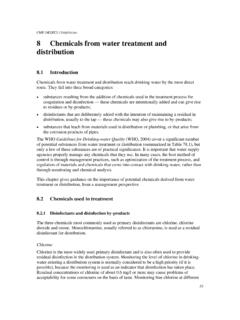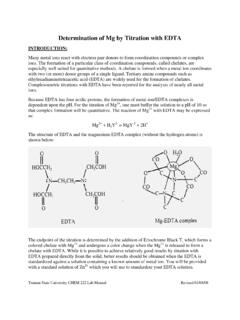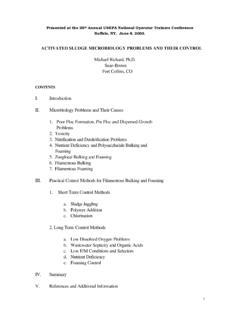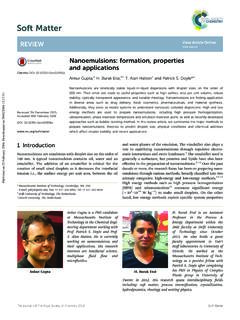Transcription of Bromate in Drinking-water - World Health Organization
1 WHO/SDE/ English only Bromate in Drinking-water Background document for development of WHO Guidelines for Drinking-water Quality World Health Organization 2005. This document may be freely reviewed, abstracted, reproduced and translated in part or in whole but not for sale or for use in conjunction with commercial purposes. Inquiries should be addressed to: The designations employed and the presentation of the material in this document do not imply the expression of any opinion whatsoever on the part of the World Health Organization concerning the legal status of any country, territory, city or area or of its authorities, or concerning the delimitation of its frontiers or boundaries. The mention of specific companies or of certain manufacturers' products does not imply that they are endorsed or recommended by the World Health Organization in preference to others of a similar nature that are not mentioned.
2 Errors and omissions excepted, the names of proprietary products are distinguished by initial capital letters. The World Health Organization does not warrant that the information contained in this publication is complete and correct and shall not be liable for any damages incurred as a result of its use. Preface One of the primary goals of WHO and its member states is that all people, whatever their stage of development and their social and economic conditions, have the right to have access to an adequate supply of safe drinking water . A major WHO function to achieve such goals is the responsibility to propose .. regulations, and to make recommendations with respect to international Health matters .. The first WHO document dealing specifically with public Drinking-water quality was published in 1958 as International Standards for Drinking-water . It was subsequently revised in 1963 and in 1971 under the same title.
3 In 1984 1985, the first edition of the WHO Guidelines for Drinking-water Quality (GDWQ) was published in three volumes: Volume 1, Recommendations; Volume 2, Health criteria and other supporting information; and Volume 3, Surveillance and control of community supplies. Second editions of these volumes were published in 1993, 1996 and 1997, respectively. Addenda to Volumes 1 and 2 of the second edition were published on selected chemicals in 1998 and on microbiological aspects in 2002. The third edition of the GDWQ was published in 2004, and the first addendum to the third edition was published in 2005. The GDWQ are subject to a rolling revision process. Through this process, microbial, chemical and radiological aspects of Drinking-water are subject to periodic review, and documentation related to aspects of protection and control of public drinking - water quality is accordingly prepared and updated.
4 Since the first edition of the GDWQ, WHO has published information on Health criteria and other supporting information to the GDWQ, describing the approaches used in deriving guideline values and presenting critical reviews and evaluations of the effects on human Health of the substances or contaminants of potential Health concern in Drinking-water . In the first and second editions, these constituted Volume 2. of the GDWQ. Since publication of the third edition, they comprise a series of free- standing monographs, including this one. For each chemical contaminant or substance considered, a lead institution prepared a background document evaluating the risks for human Health from exposure to the particular chemical in Drinking-water . Institutions from Canada, Denmark, Finland, France, Germany, Italy, Japan, Netherlands, Norway, Poland, Sweden, United Kingdom and United States of America prepared the documents for the third edition and addenda.
5 Under the oversight of a group of coordinators each of whom was responsible for a group of chemicals considered in the GDWQ, the draft Health criteria documents were submitted to a number of scientific institutions and selected experts for peer review. Comments were taken into consideration by the coordinators and authors. The draft documents were also released to the public domain for comment and submitted for final evaluation by expert meetings. During the preparation of background documents and at expert meetings, careful consideration was given to information available in previous risk assessments carried out by the International Programme on Chemical Safety, in its Environmental Health Criteria monographs and Concise International Chemical Assessment Documents, the International Agency for Research on Cancer, the Joint FAO/WHO Meetings on Pesticide Residues and the Joint FAO/WHO Expert Committee on Food Additives (which evaluates contaminants such as lead, cadmium, nitrate and nitrite, in addition to food additives).
6 Further up-to-date information on the GDWQ and the process of their development is available on the WHO internet site and in the current edition of the GDWQ. Acknowledgements The first draft of Bromate in Drinking-water , Background document for development of WHO Guidelines for Drinking-water Quality, was prepared by Dr A. Bathija, US. Environmental Protection Agency, to whom special thanks are due. The work of the following working group coordinators was crucial in the development of this document and others contributing to the first addendum to the third edition: Dr J. Cotruvo, J. Cotruvo Associates, USA (Materials and chemicals). Mr Fawell, United Kingdom (Naturally occurring and industrial contaminants). Ms M. Giddings, Health Canada (Disinfectants and disinfection by-products). Mr P. Jackson, WRc-NSF, United Kingdom (Chemicals practical aspects). Prof. Y. Magara, Hokkaido University, Japan (Analytical achievability).
7 Dr E. Ohanian, Environmental Protection Agency, USA (Disinfectants and disinfection by-products). The draft text was discussed at the Working Group Meeting for the first addendum to the third edition of the GDWQ, held on 17 21 May 2004. The final version of the document takes into consideration comments from both peer reviewers and the public. The input of those who provided comments and of participants in the meeting is gratefully acknowledged. The WHO coordinator was Dr J. Bartram, Coordinator, water Sanitation and Health Programme, WHO Headquarters. Ms C. Vickers provided a liaison with the International Chemical Safety Programme, WHO Headquarters. Mr Robert Bos, water Sanitation and Health Programme, WHO Headquarters, provided input on pesticides added to Drinking-water for public Health purposes. Ms Penny Ward provided invaluable administrative support at the Working Group Meeting and throughout the review and publication process.
8 Ms Marla Sheffer of Ottawa, Canada, was responsible for the scientific editing of the document. Many individuals from various countries contributed to the development of the GDWQ. The efforts of all who contributed to the preparation of this document and in particular those who provided peer or public domain review comment are greatly appreciated. Acronyms and abbreviations used in the text CAS Chemical Abstracts Service CT concentration time DNA deoxyribonucleic acid EPA Environmental Protection Agency (USA). FAO Food and Agriculture Organization of the United Nations FDA Food and Drug Administration (USA). GDWQ Guidelines for Drinking-water Quality LD50 median lethal dose LOAEL lowest-observed-adverse-effect level MDL method detection limit NOAEL no-observed-adverse-effect level PQL practical quantification level TDI tolerable daily intake USA United States of America WHO World Health Organization Table of contents 1.
9 GENERAL DESCRIPTION ..1. Identity ..1. Physicochemical properties ..1. Organoleptic Major uses and sources in Drinking-water ..1. Environmental 2. ENVIRONMENTAL LEVELS AND HUMAN Food ..3. Estimated total exposure and relative contribution of 3. KINETICS AND METABOLISM IN LABORATORY ANIMALS AND. HUMANS ..3. 4. EFFECTS ON LABORATORY ANIMALS AND IN VITRO TEST SYSTEMS ..4. Acute Short-term Long-term exposure ..5. Reproductive and developmental toxicity ..7. Mutagenicity and related Carcinogenicity ..8. 5. EFFECTS ON 6. PRACTICAL ASPECTS ..11. Analytical methods and analytical achievability ..11. Treatment and control methods and technical 7. PROVISIONAL GUIDELINE 8. REFERENCES ..13. 1. GENERAL DESCRIPTION. Identity Compound CAS No. Molecular formula Potassium Bromate 7758-01-2 KBrO3. Sodium Bromate 7789-38-0 NaBrO3. The Bromate ion (BrO3-) may exist in a number of salts, the most common of which are potassium and sodium Bromate .
10 Physicochemical properties (Weast, 1986). Property Potassium Bromate Sodium Bromate Boiling point ( C) 370 (decomposes) . Melting point ( C) 350 Density at 20 C water solubility (g/litre) 133 (40 C) 275 (8 C). 498 (100 C) 909 (100 C). Organoleptic properties No information is available on the taste or odour threshold of Bromate . Major uses and sources in Drinking-water Bromate may be formed in water during ozonation when the bromide ion is present (Haag & Hoign , 1983). Under certain conditions, Bromate may also be formed in concentrated hypochlorite solutions used to disinfect Drinking-water (IPCS, 2000). This reaction is due to the presence of bromide in the raw materials (chlorine and sodium hydroxide) used in the manufacture of sodium hypochlorite. Bromide is not oxidized by chlorine dioxide, so the use of chlorine dioxide will not generate hypobromous acid, hypobromite ion or Bromate (Hoign & Bader, 1994).

















